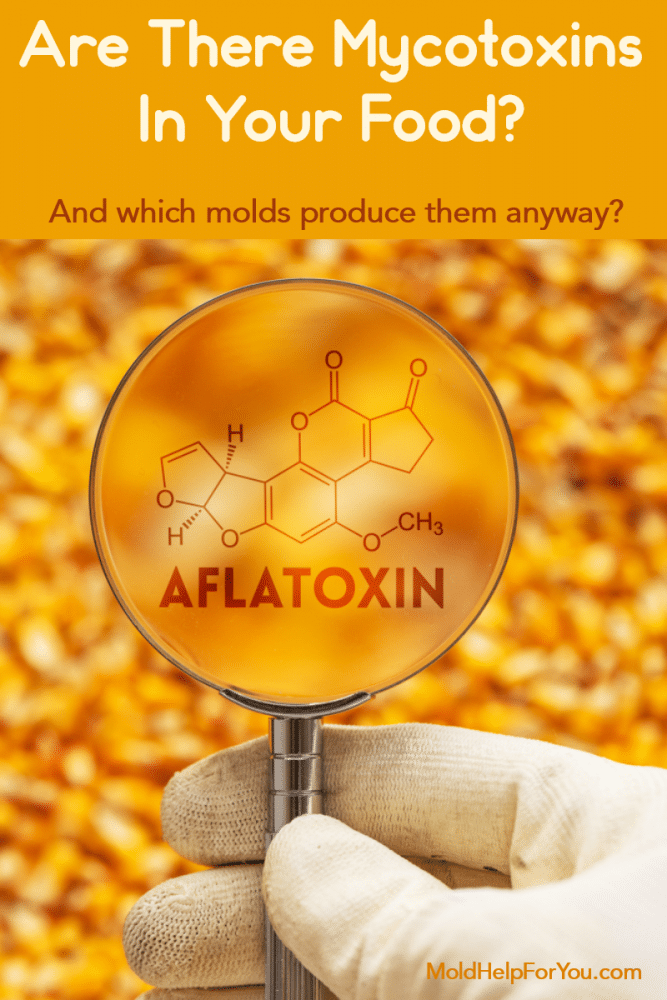The Ultimate Guide To Mycotoxins and What Makes Mold Toxic
This post may contain affiliate links. Read our full disclosure.
The term toxic mold is a bit misleading as it suggests that certain types of molds themselves are toxic. In reality, a very narrow set of molds produce secondary metabolites that produce toxins. These are known as mycotoxins.
Studies show that more than 50% of homes and more than 85% of commercial buildings in the U.S. have water damage and mold. Many experts say every home has some detectable amount of mold.
This is concerning since there is a strong likelihood that every water damaged building also has the presence of mycotoxins. This is why mold prevention and leak prevention are critical.

What Are Mycotoxins?
If you were to look up the definition of mycotoxins you would learn that mycotoxins are the toxic chemical substances that certain types of molds produce. These fungal toxins are volatile organic compounds amongst other things.
Mycotoxins are as small as 0.1 microns. For reference, mold spores are between 1 and 20 microns.
Mycotoxins typically replicate on and attach to floors or walls in humid and confined environments or on certain foods. However, mycotoxins can be found on any type of surface or material.
Why Are Mycotoxins Produced?
Mycotoxins are thought to possibly play a role in helping to prepare the substrate on which the molds exist for digestion. They have also been found to act as defense mechanisms. Mycotoxins may be produced when the organisms are under stress, which could be related to competition/defense, or simply due to inhospitable environmental conditions.
Which Types Of Mold Produce Mycotoxins?
Remember that there are many species of mold found within each main type of mold. Not every species of a type of mold will produce mycotoxins. It should be noted that not all mold genera have been tested for toxins, nor have all species within a genus necessarily been tested.

The most common and dangerous mycotoxin producing molds are:
- Alternaria
- Aspergillus
- Chaetomium
- Cladosporium
- Fusarium
- Myrothecium
- Penicillium
- Stachybotrys
- Trichoderma
- Thrichothecium
What Are The Types Of Mycotoxins?
There are over 400 mycotoxins, most of which are cytotoxic (toxic to living cells). There are 6 specific mycotoxins which are considered the most dangerous to humans.
Aflatoxins

Aflatoxins are one of the most potent carcinogens known to humans. Aflatoxins are produced by different species of Aspergillus, particularly Flavus, Oryzae, Fumigatus and Parasiticus, as well as members of the genera Penicillium. Strains of Aspergillus Flavus and Parasiticus produce mycotoxins under favorable conditions.
The most important aflatoxin mycotoxins are B1, B2, G1, G2 and M1.
B1 is the most abundant aflatoxin mycotoxin. It is also the most toxic and carcinogenic. M1 is a mycotoxin that comes from animals after the animals have eaten feed contaminated with aflatoxin mycotoxins. For example, M1 can be in cows milk after cows have eaten aflatoxin mycotoxins.
While aflatoxin mycotoxins mainly affect agriculture, they are frequently found in water damaged buildings.
A few important facts about aflatoxins
- Aflatoxins are present in the food chain.
- Aflatoxins are mutagenic, carcinogenic, teratogenic and immunosuppressive.
- Aflatoxin B1 can cause mutations to both nuclear and mitochondrial DNA meaning they can cause mitochondrial damage.
- Aflatoxins cause aflatoxicosis which is characterized by liver damage in both humans and animals.
- Aflatoxins cause an increase in circulating alpha tumor necrosing factor, suggesting that these mycotoxins are also immunotoxic in humans. In animals, immunosuppression does occur in a variety of different species.
- They have been found in human cord blood and sera and apparently can enter the developing fetus in humans and animals.
- Aflatoxins have been found in human breast milk, infant formula, cow’s milk, and dairy products.
Fumonisins

Fumonisins are produced by species of Fusarium.
In the U.S., the ingestion of moldy corn was first associated with adverse health effects in farm animals.
In humans, Fumonisins have been associated with esophageal cancer from ingested contaminated corn. Fumonisins are liver and kidney toxins and carcinogenic in rodents. They are also known neurotoxins.
More recently, they have been implicated in birth defects (neural tube) in humans and animals.
Ochratoxins

Ochratoxins are a mycotoxin produced by species of Eurotium, Aspergillus, Fusarium and Penicillium. There are three generally recognized Ochratoxins, designated A, B and C. Ochratoxin A (OTA) is chlorinated and is the most toxic, followed by OTB and OTC.
Ochratoxins are found in many food crops, including cereals, beer, wine, coffee, cocoa, grape juice, dried vine fruits, poultry, and milk.
A few facts about ochratoxins
- Ochratoxin is damaging to the kidneys and liver and is also a suspected carcinogen. There is also evidence that it impairs the immune system.
- Ochratoxins have been implicated in urinary tract tumors in humans.
- OTA is mutagenic, carcinogenic, teratogenic and immunosuppressive in a variety of animal species and in humans.
- It is a mitochondrial poison causing mitochondrial damage, oxidative burst, lipid peroxidation and interferes with oxidative phosphorylation. In addition, OTA increases apoptosis in several cell types.
- OTA causes immunosuppression following prenatal, postnatal and adult-life exposures.
- OTA has been found in human and cow milk. It is also present in human blood.
T-2 Toxin

T-2 Toxin is a tricothecene produced by species of Fusarium and is one of the more deadly toxins. If ingested in sufficient quantity, T-2 toxin can severely damage the entire digestive tract and cause rapid death due to internal hemorrhage.
T-2 has been implicated in the human diseases alimentary toxic aleukia and pulmonary hemosiderosis. Damage caused by T-2 toxin is often permanent.
Trichothecenes

The trichothecenes are a large family of metabolites (over 60) produced by several species of molds including Fusarium, Myrothecium, Trichoderma, Trichothecium, Cephalosporium, Verticimonosporium and Stachybotrys. All trichothecenes are considered mycotoxins and are one of the most toxic types.
Some of the trichothecene mycotoxins are deoxynivalenol, nivalenol, vomitoxin, HT-2 and T-2 mycotoxin. T-2 mycotoxins are defined as mononocyclic and have been used in biological warfare.
They are remarkably stable under different environmental conditions, including typical cooking temperatures.
A few facts about Trichothecenes
- All trichothecenes are toxic to humans, other mammals (domestic and research), birds, invertebrates, plants and eukaryote cells.
- They are more toxic via the lungs verses other means of exposure.
- Trichothecene mycotoxins suppress the immune system.
- Trichothecenes are potent inhibitors of protein synthesis. They bind to ribosomes, inhibiting protein and, subsequently, RNA and DNA synthesis. Rapidly proliferating tissues (intestines and bone marrow) are most adversely affected.
- They are lipid soluble, crossing cell membranes, causing lipid peroxidation with mitochondrial and cellular membrane.
- Trichothecenes cause increased cell death (apoptosis) by inhibiting cell division in a variety of cell types via mitochondrial and non-mitochondrial mechanisms.
- Trichothecenes readily cross the placenta.
- Trichothecene mycotoxins are found both in water damaged buildings and on crops.
- Trichothecene mycotoxins are also very resilient and stable and not easily removed. They have a life span of a decade or more.
Zearalenone

Zearalenone is also a mycotoxin produced by Fusarium molds. Zearalenone toxin is similar in chemical structure to the female sex hormone estrogen and targets the reproductive organs. It affects the male reproductive system as well.
Are Mycotoxins Dangerous?
Yes. The toxic effect of mycotoxins on animal and human health is referred to as mycotoxicosis.
Mycotoxins have four basic kinds of toxicity: acute, chronic, mutagenic and teratogenic. In addition to these, mycotoxins can be carcinogenic, estrogenic, hemorrhagic, immunotoxic, nephrotoxic, hepatotoxic, dermatoxic and neurotoxic. (Mili?evi? et al., 2010).
Molecular structures of mycotoxins vary widely, so their effects on human and animal health also vary widely. The extent of adverse effects of mycotoxins on human or animals health mainly depends on the extent of exposure (dosage and period), type of mycotoxins, physiological and nutritional status as well as possible synergistic effects of other chemicals to which the animals or humans are exposed.
Mycotoxins can affect all organ systems, but individual mycotoxins usually target specific organ systems. Species differences are generally related to severity of effect, although in some cases target organs may differ according to species. Some mycotoxins cause primarily acute and highly reversible effects, others cause irreversible organ damage, and still others cause both acute and chronic effects, depending upon exposure levels, time course, and other circumstances.
The most commonly induced diseases include liver cancer, kidney failure, and effects on the brain or nervous system.
Some people are more susceptible to getting mycotoxicosis than others, and this is due to the pharmacogenetic variability where specific gene mutations such as cytochrome p450 (CYP 450) genes could either increase or decrease the metabolic activity (cytotoxicity) of the challenging mycotoxins (Sun et al., 2016).
In addition, about 25% of Americans also carry a gene called HLA-DR (human leukocyte antigen) that makes it more difficult for them to excrete mycotoxins. In people with the HLA-DR gene, their body is unable to recognize toxins as a foreign invader, so they don’t produce the antibodies needed to remove mycotoxins. This population is also more likely to develop Chronic Inflammatory Response Syndrome (CIRS), an out-of-control inflammatory response to toxins.
Aside from the fact that mycotoxins are known inhibitors of DNA, RNA, and protein synthesis, they have the ability to destroy human health (mentally and physically), and never appear in an autopsy. This is why they are used in biological warfare.
Frequently, mycotoxicosis remain unrecognized by medical professionals.
How Do Mycotoxins Get Into The Body?
Mycotoxins may enter the human and animal system in one of three ways. Ingestion, dermal, or inhalation.
When mycotoxins are ingested, they enter the body either by indirect or direct contamination. Direct contamination occurs when a food or feed becomes infected with a toxigenic fungus with subsequent toxin formation.
In contrast, indirect contamination can take place when an ingredient of a process has previously been contaminated with toxin-producing fungi and while the fungus itself may be killed or removed during processing, the mycotoxin will mostly remain in the final product. And example of this is cereal.
Mycotoxins can enter the body through the skin (dermal) or the eyes. The eyes are actually the easiest and most direct way that mycotoxins enter the body systems. If mycotoxins enter the body through the skin, this is most likely because your body was in direct, recurring contact with a contaminated source (clothing, linens, furniture, car). Typically this is the least common entry point for mycotoxins.
Mycotoxins are present in the air and therefore easily inhaled. They make their way through the sinuses or mouth and into the body.
How Do You Test For Mycotoxins?
While there are a couple of ways to test for mycotoxins in the home, the preferred and most accurate method is through dust sampling.
The Environmental Mold And Mycotoxin Assessment (EMMA) is available through Real Time Labs. It is the mycotoxin test that I rely on and have used with success in the past. The EMMA test uses sensitive molecular detection technology to look for the presence of 10 of the most toxigenic molds. It determines their presence and determines their relative abundance. EMMA also tests directly for 15 of the most poisonous Mycotoxins using its patented Mycotoxin detection test. Testing is simple, only requiring small amounts of dust or material from AC or heater filters.
The other option is to find a local environmental hygienist or mold inspector who has a relationship with a lab where they offer direct sampling. The downside of this is that you are testing a specific object of piece of your home and this may not reflect what is occurring throughout the building.
If you are looking to test yourself for mycotoxin exposure, you can have this done via a urine sample.
The only laboratory I recommend for mycotoxin testing of urine is RealTime. It is the only laboratory licensed by the College of American Pathology and CLIA for urine mycotoxin tests. Go to the website for RealTime Laboratories for further information.
The other lab that offers mycotoxin urine testing is Great Plains Laboratory. I haven’t used them personally but they have a good reputation.
How Long Are Mycotoxins Toxic For?
Mycotoxins are toxic for a very long time. According to experts, trichothecene mycotoxins can remain toxic for several years. Dr. Jack Thrasher a leading toxicicolgist (who I personally worked with) has suggested that trichothecene can remain toxic for over a decade. Trichothecenes are probably the most long lasting mycotoxin.
How Do You Kill Mycotoxins?
Mycotoxins aren’t actually alive like mold spores. So when we talk about killing mycotoxins it really means breaking down mycotoxins and their toxicity so they are no longer dangerous to humans.
It takes fire at 500 degrees Fahrenheit (260 degrees Celsius) for half an hour or fire at 900 degrees Fahrenheit (482 degrees Celsius) for 10 minutes to destroy trichothecene mycotoxins. Those mycotoxins don’t have any desire to be eradicated.
Ozone is supposed to kill most or all mycotoxins. However the level of ozone you need to kill mycotoxins is not safe for humans. So if you use an ozone generator there must be no one in the house.
Things like ultraviolet light or freezing temperatures do not have much effect on mycotoxins.
HEPA air filters are not effective at removing mycotoxins. Activated carbon filters can remove mycotoxins from the air however.
Mycotoxins do eventually break down and lose their toxicity after some time. But like I mentioned above, trichothecene mycotoxins are among the most resilient and can take years to break down.
When it comes to breaking down mycotoxins, there are three product lines on the market that I have used and had great success with; Microbalance, Citrisafe, and BioBalance.
Microbalance products have been subjected to independent lab testing, performed by RealTime Laboratories, Inc, against a range of molds and their toxins. The lab concluded that EC3 Mold Solution Concentrate will “eliminate aflatoxins, ochratoxins, and tricothecenes at concentrations of 1000 ppb if the solution is diluted no more than 1:40.” Note: The instructions on the bottle will guide you for proper dilution, so that this won’t be a problem.) The EC3 Candles whose mechanism is to aerosolize the citrus extracts into the air as they burn, were found to decrease known concentrations of mycotoxins in the air at 500 and 1000 parts per billion by 90% in 3 hours burn time. Mycotoxins in the 250 parts per billion range were completely eliminated in 3 hours.
So how do these product lines work?
Even though Microbalance is the only product line to go through the testing certification, the products all work the same.
Citrus seed extracts (part of the proprietary blend of ingredients in the various products) were found to control the growth of food-borne fungi and to prevent mycotoxin biosynthesis. When mycotoxin biosynthesis is halted, molds become inert and much less of a health threat.
This information spurred testing of citrus seed extracts as possible solutions for the treatment of indoor molds and mycotoxins. Low concentrations of citrus extracts, when applied to the tested molds resulted in changes of the cell structure, inhibiting respiration and changing the permeability of the cell membrane, whereas high concentrations lead to severe membrane damage, loss of homeostasis and cell death.
Science also shows that the fungitoxic effects of citrus seed extracts is a consequence of hydrogen bonds forming between hydroxyl groups of phenolic compounds and active sites of cellular enzymes. The active components cause loss of integrity of the cell wall, and thus the loss of cytoplasmic constituents from the mold hyphae. This is important, because when the hyphae are damaged, the mold cannot take root, spread, or reproduce.
I highly recommended choosing from these products both as part of a regular mold prevention protocol but also to remove and denature mycotoxins:
- EC3 Mold Solution Concentrate
- EC3 Candle
- Remedy Mold Treatment Concentrate
- Remedy Multi-Purpose Mold Treatment Wipes
- Remedy Air Treatment Dispenser
- Any of the BioBalance Havenmist or Havenfog products
If you would like to read a more in depth post about the EC3 product line, check out Do EC3 Products Really Work. I also discuss the BioBalance products in my post on Mold Control Foggers.
What Foods Are Mycotoxins Found In?

It is now widely agreed that approximately 25% of the world’s food crops are affected each year by variable levels of mycotoxins which can have considerable economic consequences for the crop, livestock producers, grain handlers, processors, consumers and national economies. It has been conservatively estimated that annual losses in the US and Canada, as a result of mycotoxin occurrence, to the feed and livestock industries alone can be in the region of $5 billion.
Most disturbing is that since mycotoxins greatly resist decomposition or being broken down in digestion, they remain in the food chain in meat and dairy products. Even temperature treatments, such as cooking and freezing, do not destroy some mycotoxins.
10 foods highly contaminated with aflatoxins are:
- Coconut
- Corn
- Dairy products (most readily from cow’s milk – sheep and goat milk products are usually saf)
- Grains (including grain based baked goods, breads, cereal, crackers, and pasta)
- Grapes
- Maple Syrup
- Nuts and Nut Butters
- Orange Juice
- Wheat
- Wine
Food highly contaminated with other mycotoxins include:
- Apples
- Barley
- Beans (dried)
- Cheese (some but not all and mostly hard cheeses)
- Coffee Beans
- Cottonseed
- Dried fruits
- Herbs (dried)
- Lentils
- Peas (dried)
- Peanuts
- Rye
- Sorghum
- Sugar Beets
- Sugar Cane
- Tea (in bags)
- White potatoes
Please use caution when consuming the foods listed above especially if you are currently being exposed to mold or are detoxing from mold exposure. Coffee is obviously a difficult product for people to give up so please read my article on Mycotoxin free coffee brands that are tested and safe for consumption.
Additional sources for this article include:
- https://www.drthrasher.org/mycotoxins
- https://www.ncbi.nlm.nih.gov/pmc/articles/PMC164220/
- https://www.who.int/news-room/fact-sheets/detail/mycotoxins
- https://www.frontiersin.org/articles/10.3389/fcimb.2018.00060/full
- http://www.micotoxinas.com.br/Boletim46.pdf
- Bullerman, L., Bianchini, A. (2007). “Stability of mycotoxins during food processing”. International Journal of Food Microbiology. 119(1–2): 140–146
- Wanda M. Haschek, Kenneth A. Voss, in Haschek and Rousseaux’s Handbook of Toxicologic Pathology (Third Edition), 2013
- John I. Pitt, in Foodborne Infections and Intoxications (Fourth Edition), 2013
- J.E. Smith, in Food Chemical Safety: Contaminants, 2001



hi, I am concerned I am living in a mold environment. I rent and have lived here for 4 years. my son has allergies and a slight cough and is always tired. I cannot smell that well and I feel foggy all the time and would like to move but cannot find a decent place right now. is my landlord responsible for a sick house and what can i do ?
Hi Cathleen! I am so sorry that you are going through this! I have an article on my other website that addresses the whole landlord / tenant situation. In short, yes, your landlord is responsible. Have a look at the article and reach out to me with any questions at all! https://hybridrastamama.com/mold-in-a-home-you-are-renting/ (I am slowing updating and moving my mold content from my other website over to this one.)
I am dealing with this now, after years of worsening symtpoms and after mold inspectors couldn’t find anything. Finally, I did a urine test which came back positive for 3 different mycotoxins, and found mold behind the shoe cabinets in my closet. Now I’m so scared, I want to open every wall, even where there has never been a leak. am I over-reacting? Can mycotoxins travel through drywall and out of sealed environments, like the attic, even if the drywall has never had mold on it?
Mycotoxins are still not completely understood in terms of their capacity to travel. Can they get into spaces you would not think they could? Absolutely. They are impossibly small. For a situation like yours, if remediation has been completed in the impacted area, I would go ahead and do a whole house fogging. https://moldhelpforyou.com/best-mold-control-fogger/ This article offers a lot of information and please feel free to contact me with questions.
How does one remove mycotoxins from the home on walls, floors and countertops after remediation? Products recommended are Benefect, vinegar, Everclear, theives, ammonia. Do you have a recommendation?
Hi Mary Anne! Walls are tricky because mycotoxins could be IN and not just ON the walls. Currently the only products that have been proven to truly render mycotoxins inactive are the EC3 products and ammonia. Here are links to my posts on those:
https://moldhelpforyou.com/ec3-mold-solution/ and https://moldhelpforyou.com/does-ammonia-kill-mold/. Let me know if you have additional questions! Happy to help!
Do you know if Benefect Decon 30 neutralizes/kills mycotoxins? Also, if mycotoxins can be in walls, would it be better to fog vs. wipe down with something to get rid of them?
Hi Juls! Benefect Decon 30 has not been tested on mycotoxins. Based on the ingredients, is MAY have some ability to neutralize SOME mycotoxins but it would not be my first choice in products. Thermal fogging with the correct solution is the best way to deal with mycotoxins inside walls but remember, it will only penetrate so far. Wiping down the walls won’t be of much help if the mycotoxins are inside.
Hi Jennifer, impressive work you have here…
Helping a friend feed her horse she had left a new bag of grain in front of her house (on my property) and when I went to pick it up there was the addition of a salt block & a 1/2 sack of feed (not unusual as she works at the race track.) When I went to dump the 1/2 sack into a feed bin, located in my car, it choked me and burned my eyes… Now, a few days later, I cant go near my car, house or barn, even with a N95 mask I can feel the burn & taste the nasty… Dose this sound like mycotoxins?
FYI In my 50s and my occupation as a rennovation contractor placed me in many positions of remediating minor mold issues, until about 10 years ago. Though, never certified, I had always researched & applied the recommended procedures at that time. Maybe worth noting, I had never experienced any negative effects in theses experiences.
Being a lean year, last year, and so far, worse this year it looks like I will have to reeducate and do it myself. Any guidence would be greatly appreciated.
Sincerely
Dick Jude
Hi Don! Sorry to hear this and yes, my guess is you got hit by mycotoxins. Not sure where the feed comes from but for the past year, grains have been even more contaminated than normal. COVID played a role but so did weather in different parts of the country. I am finding more and more contamination on food. You absolutely need to remediate your car. https://moldhelpforyou.com/car-mold/ Take a look at that article and let me know if you have questions.
For additional information on the mycotoxin aflatoxin – which causes deadly liver cancer – read the most helpful book titled The China Study by T. Colin Campbell, Ph. D. His research demonstrates how one can mitigate harm to one’s liver via diet. This book is a result of 30 years of scientific research distilled and presented for the lay person. Very easy to read and an extraordinary amount of scientific information. If you are worried about mycotoxin aflatoxin exposure this book will help you.
Thank you.
Hello:
Are you aware of any mold remediation companies in the U.S. which use EC3?
Thank you for your time.
Hi,
Really interesting reading! I’ve only skimmed a few articles as you are so thorough but read through alot of them…I will get to the rest soon.
I am 33 and have had crazy sinus issues for about 7 years…weird taste, headaches, brain fog, reflux…the works! I have never known the cause and I’m still waiting to see an allergist to find out what I might be allergic to (should be a matter of a couple months hopefully) but I just remembered the other day that when my problems first started I thought there was something in the vents of this used car I bought because I started getting this horrible metallic taste in my mouth around the time of purchase…it was waterlogged in the back seat floor area because the window wouldn’t close so I just fixed the window and dried it out with towels…then when I was diagnosed with sinusitis and later chronic rhinitis I didn’t think anything more about the car but after hearing some peoples stories on fb support groups it clicked that I could’ve been exposed to mould in that time as I was driving like an hour each way to work for a good few months with windows closed in the winter. Luckily the car died not that long after I bought it which I guess was lucky in the end. Anyway Just wondering how worried I should be about mold spores in my home if there is no actual mold growing and no moisture issues (apart from the shower of course.) I had a couch I got from the side of the road and have just chucked it after remembering the car thing as I realised it might’ve been hiding some mold…now I’m worried about dry spores having settled around my small flat. Will they eventually just go away if I’m running a carbon filter air purifier and washing sheets regularly? Or are there other things I should be doing? Also think I read that you said temperature doesn’t affect mold? Did I read that correctly because I have read in multiple places that it can’t survive more than 55 degrees Celsius…I was just about to go put some clothes in the dryer for this purpose before reading one of your articles!..came up in google when I was searching for how to kill mould in laundry. Also I noticed you recommended doing sinus rinses? Just curious if I should be doing them because whenever I use saline spray or do a proper sinus rinse with the sachet (only done full rinse once) it seems to make my condition way worse…my issue is more sinus walls expanding rather than mucus buildup. Did you experience this at all or did it give you relief like it seems to with most sinus issue sufferers?
Oh and do you recommend using the ec3 candle even though I have an air purifier with carbon filter? Really appreciate the time you have put into this. ❤️❤️❤️
Hi Jennifer, This was very helpful information. Long story short, my son has PANDAS and while we were testing him for many things, one test we did was for the presence of Mycotoxins. We used Great Plains Labs. His test came back positive for Ochratoxin A at a range of 27.75 (normal being <7.5). The problem I am having is we have NO water damage or mold presence (like what was described in your About Me story). We had a remediation company come out and we are moving fwd with them. They are having a mold inspector come tomorrow to collect samples. My question is what else should I do or look for? Also how is Mycotoxins cleared from the body?
Thanks so much
There are medical applications for ozone use. You can use medical ozone as a sauna for example. It’s a very effective method to get rid of fungus, virus and bacteria in the body. It also helps produce stem cells so can heal damages and to boot also has nice effects on the skin and hair. Look for a holistic, integrative or functional medicine doctor who can do this or teach you. You can do it at home after learning how to do it properly.
Most of all don’t give up hope. There is always an answer somewhere, even if it’s hard to find sometimes. Best wishes to you and your son ❤️❤️❤️
Thank you! This is such helpful information! I’m wondering if “dry cleaning only” clothing can be salvaged? Or must we throw out if cannot be hand washed with EC3? Also a Canada Goose down coat that was in an apartment where unknown mold exposure occurred for 3 months and a down comforter. Any guidance would be appreciated.
Hello, I have recently had mold mitigation for my home. My car and house still have mycotoxins. The mold I had was Aspergillus and Penicillium so the mycotoxin I’m dealing with should be Ochratoxin A. Will fogging my car and house with havenfog work for this specifically? I’ve tried EC3 and no dice.
Hi Carlos. You will want to use the thermal fogger with the Havenfog for this. It really is the gold standard for fogging to tackle mycotoxins. I love EC3 but have found that the mist just doesn’t get into the same spaces that the fog can.
Hi, Jennifer! Which thermal fogger do you recommend for treating mycotoxins in a home?
Hands down this fogger: https://biobalancenow.com/product/biobalance-large-fog-kit/?wpam_id=1 If you are interested in purchasing it, please let me know and I can get you a coupon code.
Can I please have a coupon code to purchase.
Hello Christine,
What product are you looking for a coupon code for? I can only email those, not post publicly.
Can I get a coupon for the best fogger you recommend. Thank you so much!
Hi Kendra! Yes, I will email that to you!
Excuse me but why exactly do you say that HEPA filters are ineffective at removing mycotoxins from the air? I find that hard to believe since it would run contrary to HEPA filter standards — for which the minimum required removal efficiency is 99.97% of ANY particulates of ANY size from air passed through the filter.
Is is because of mycotoxins’ small size? If so, you might be under a pretty common misconception about how HEPA filters work. Here, I’ll just quote a journal article explaining it:
“To qualify as HEPA grade, filters must remove at least 99.97% of all particles that are 0.15 to 0.2 µm, for which HEPA filters are least effective. Thus, HEPA filters have at least 99.97% efficiency for removing all particles, with even higher efficiencies for particles both larger and smaller than 0.15 µm (Figure 2). The interesting U-shaped efficiency curve of all HEPA filters, which has a minimum at 0.15 µm, is due to the relative effectiveness of the 3 mechanisms of particle capture at various sizes. Filters with efficiencies >99.99% are also termed ultralow penetration air filters.”
Hi Bob! Believe it or not there is a lot of false advertising when it comes to HEPA filters. 90% of all purification systems sold on the market DO NOT have the capability to trap toxins less than 5 microns. Most mycotoxins are 0.1 microns in size. But more importantly, even true HEPA filters have a fault. When a HEPA filter traps a mold spore the mold spore still has “life.” As such, anything trapped on the filter can grow. This is called biostasis. Biostasis reduces something called the “breathe-through” effect, meaning the air passing through the filter doesn’t pick up small fragments like mycotoxins as they fly by. Also as important, most mycotoxins travel ON other particles. They typically don’t just float around independently. So now there is a size increase to account for. There are a lot of layers as to why HEPA filtration is not full proof for picking up mycotoxins. Hence why they are ineffective typically.
Currently own a fixer property which had 3 main leaks. There is no doubt the house is ridden with mold inside the walls and everywhere else. My plan is to replace all the drywall, insulation and plywood where the leaks reached. How would you go about treating the actually framing studs that aren’t as simple to replace? I’ve been spraying vinegar/hydrogen peroxide mix. Very frustrated and contemplating bulldozing the whole place and starting over before putting more money into this so thanks for your time!
I am so sorry to reply to late!!!! I had major surgery a month ago and am just getting back on my feet. 12% hydrogen peroxide is what I personally use in these situations.
Wow, I didn’t know that brain fog can also be caused by molds. I’m interested in looking for mold testing services soon because I’m thinking about getting some renovations done to my attic. As such, I will first need to make sure that the molds up there are handled properly.
Great article.
Is it true that all black mold is not toxic?
Hi Kevin! You cannot determine a mold’s toxicity based on color. Black mold is just another color of mold and is no more or less toxic simply because of its black appearance. Please don’t mistake this as meaning that black mold is not toxic. It can be and usually is. And black mold is not the only toxic mold. The only way to truly know what species the mold is, is to test it.
My dirt floor crawl space was a possible source of mold. An inspector identified high counts of mold on a dust sample, which is probably not a surprise. I encapsulated the entire crawl space, sealed against the foundation walls, with a 20 mil (0.020 inch) CleanSpace (r) polyethylene liner. Will such a liner prevent any mycotoxins from penetrating, and gaining access to the crawl space?
Hi David! Mycotoxins are a little complex and not completely understood. In theory, yes, you have done what you can to prevent the mycotoxins from gaining access. Could they possibly find a breach somewhere and exploit it? Absolutely. But 20mil is very thick and should be quite effective.
Do you have a step by step cleaning list for what to do after professional remediation? I’m thinking of something like the step by step guides to deep-cleaning like you can find on Pinterest. Just something a busy mom of 3 can print and work through step by step.
Hi Kelli! I am so sorry for just now seeing this. I do not have this but actually this is a great idea! Let me get to work on this.
this article is tbe best thing l have seen, nit much info on mold toxins. i had mold in my crawl space, found it after becoming very sick after having my rugs cleaned. i had the crawl space cleaned and encapsulated, and the house was gased with chlorine dioxide and the rugs removed, but no mold was found under the rugs or on the pads. I got rid of all my stuffed furniture, lots of clothes and belongings i didnt wsnt to clean, wiped down everything else left in the house, floors walls, belongings with vinegar, or bleach, but still cant be in the rooms that had the rugs incthem. i still have bare plywood floors, which i primed one large room thinking it would help, but still have to wear a mask when i go in, but can stay very long. i need help to know what else i can do, to live in my house, its been 7 long months. thank you for any help you can give me.
Hi Lorrie,
I am so sorry you are going through this. My suggestion would be to fog your entire house. Would you like more information on that?
Hello I left you an email starting with “mfix” , hope to hear back its regarding mold in a home and also questions I specifically had, im in the process of trying to breakdown how to address all possible issues and so I had some questions I sent you to start off with, please let me know! Thanks